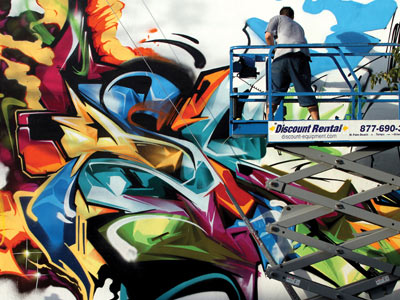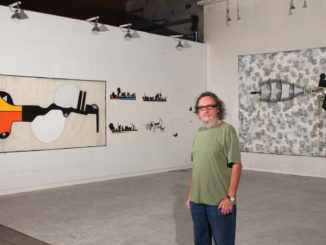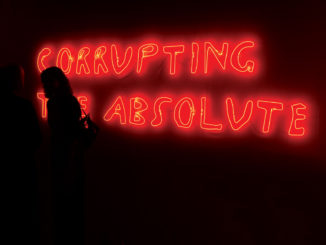 It was impossible not to run into street art during this year’s Art Basel Miami Beach – either out on the streets or on indoor walls at various exhibition spaces and galleries. It came from the hands of an astounding array of artists – local, national, and international. For instance, if you missed Shepard Fairey’s work, large or small, inside or out …well, you couldn’t have, really, because he was all over town. But following his path around might be a good way to recap the incredible proliferation of what we call street, or graffiti-inspired, art in Miami, at the end of 2009.
It was impossible not to run into street art during this year’s Art Basel Miami Beach – either out on the streets or on indoor walls at various exhibition spaces and galleries. It came from the hands of an astounding array of artists – local, national, and international. For instance, if you missed Shepard Fairey’s work, large or small, inside or out …well, you couldn’t have, really, because he was all over town. But following his path around might be a good way to recap the incredible proliferation of what we call street, or graffiti-inspired, art in Miami, at the end of 2009.
Fairey, of course, is now one of the best known artists in the world, thanks to his “Hope” poster of President Barack Obama, now an iconic image across the globe. He in fact started putting up/sticking up his brand of wall art around Miami years ago. Standing in front of his huge mural at the Miami Art Museum, a version of his Arab Women first created in 2006 that was unveiled during Art Basel Miami Beach on Dec. 3rd, Fairey commented: “I used to come down here and throw stuff up illegally. Now, not so much so,” he laughed as a group of photographers approached to snap him in front of the work.
So, starting over on the Beach, on opening evening of Dec. 2nd, small Fairey works could be seen as part of Primary Flight’s “Blue Print for Space” group exhibition – indoors – at ArtCenter/South Florida. Tell-tale red and black, tapestry-like pieces from Fairey included politically infused titles such as Tyrant Boot, and references to his once ubiquitous obey stickers. But he was just one of many amazing collaborators in this show. Brooklyn-based Logan Hicks hung his stencil versions of urban landscapes; the London Police put up a piece with their signature images, black and white smiley faces bouncing around our city, called Miami Nicely; Ron English’s Grin on Grass was a creepy interpretation of just that, a large head with skeletal teeth, grinning. And the locals delivered quite a punch too.
Blackbooks’ humorously titled Pushing Two Keys was a sculpture partially crafted from a speaker and keys; Retna’s polystyrene piece, incorporating those now-familiar symbols, was instantly recognizable for those who know his walls, as was Santiago’s entry. And Typoe’s word piece Click Clack was simple and arresting.
That summarizes the whole show – a strangely simple, quiet, and sophisticated exhibit; strange because of the cliched notion that shows related to urban art must somehow be loud and hyper-active. (The opening night and after party were anything but quiet, but during Art Basel Miami Beach that would be a death sentence.)
Primary Flight is an art collective that started covering walls in Wynwood back in 2007 with a crew of local and national artists that has grown every year, and by the time Primary artists took to the streets this past December, the numbers of painters and walls had exploded.
If we move with Fairey over to the Miami side, where he worked on a Primary Flight wall at 30th Street and Miami Avenue, we can observe this explosion. From 23rd Street up to about 40th, and from North Miami Avenue west to NW 6th Street, literally dozens of outdoor murals from over 100 artists can now be found, and appreciated, for the strolling. These include some surprisingly monotone and somber works, as well as those that are more associated with the classic graffiti style.
This year, New York’s Deitch Projects and developer Tony Goldman got into the act, with a mural “park” called Wynwood Walls, covered by an impressive roster of internationally known artists. And sure enough, we can follow Shepard Fairey here, as he was commissioned to do two walls in this area on NW 2nd Avenue between about 22nd and 28th streets. On the opening for Wynwood Walls on Dec. 3rd, sprawling, colorful murals from the likes of Futura, Barry McGee, Kenny Scharf, and Swoon were joined by foreign artists such as Japan’s Aiko and Brazil’s Nunca and Os Gemeos.
Throughout the week, people had been pulling up by the carload to watch the creation of, for instance, the outrageously colorful outer wall by Os Gemeos, or the funky, almost-botega-looking mural from McGee. By opening night a crescendo took place, with thousands milling about, both inside the mural park and around the neighborhood. An audience pleaser of this night was the gold-hued, Byzantine-styled mural from the Greek Stelio Faitakis, who referenced Native American art along with Ocean Drive Happy Hours – a slam dunk.
Like Primary Flight, Goldman hopes to add to these murals (12 at this point) throughout the months and years to come, adding at least 15 more: “I’d like to see it [become] an international street art museum,” Goldman says about Wynwood.
Interestingly, those who saw the fantastic Nunca mural on opening night got only a limited view – at that point it was partially finished and over the next week, took on an entire new veneer and color-scheme, truly a testament to an “evolving” art project.
Up the street, Fairey’s Public Works 120-foot mural on shipping containers was unveiled to be a montage/collage of some of his most familiar works in, of course, red, black, and white. As Fairey’s MAM courtyard mural was introduced the same night, one could be excused for thinking that his veiled woman imagery on massive walls had become as ubiquitous as his little “obey” stickers of years past.
But while all this wall art engulfed the streets of Wynwood and seemed hard to compete with, a few short blocks north in Midtown, in a new-town building, yet another graffiti art show was taking place during Basel.
At this point, it became clear that Shepard Fairey was not the only commonality among urban art shows – so was a connection to Brazil. From highlighting favela culture to serving caipirinhas, Brazil was the de rigeur component at all the shows. “Blue Print for Space” served the national Brazilian cocktail, Wynwood Walls served up a couple Brazilian artists, and the show in Midtown – “Graffiti Gone Global” – served both plus a sculptural replica of a favela at the entrance (although controversy surrounded the actual sculpture, as the local artist who first designed it did not complete it).
Sponsored by SushiSamba (a Brazilian-Japanese restaurant chain) and curated by the authors of the book Miami Graffiti, James and Karla Murray, this was another exuberant event.
During Art Basel Miami Beach, live outdoor painting of canvases and bodies took place, while the industrial grey and brick interior space hosted artists from Brazil, Japan, and the U.S. – two large floors full of them. The 4,000 sq.-ft. space at NE 1st Street, a raw retail hall, had to be fitted and lit in little more than a month ahead of time, according to Karla Murray. But by the time the artists took their places, the vast space felt like an appropriate home for graffiti – far less a white cube than a location where just such artworks would likely be found – empty warehouses, train stations, and so on. So work from Lady Pink and Ewok and local Crome (all of whom can be seen on various walls in Wynwood) looked vibrant; those meso-American stylings from the Brazilian Vitche jumped out; and an amazing amount of interesting pieces from women artists (not a hallmark of graffiti shows anywhere) helped frame the show.
In one interesting interaction, a photo of a store-front taken by the Murrays, blown up to partial size, was painted over by the likes of Billi Kid and Shiro – the store-front wasn’t real, the graffiti wasn’t illegal, and the act itself was meant to be seen by as many eyes as possible. A fascinating twist, and metaphor for all the street art happenings of Art Basel Miami Beach 2009.
Graffiti has not only gone global, but outdoors to indoors, illegal to legal, non-commercial to commercial, ghetto to gallery. It’s really nothing new, either – Basquiat or Herring could attest to that. And three shows, all of which claimed on some level or another to have brought the largest concentration of street art to Miami during this Art Basel Miami Beach, have left the city far richer visually than it was just one month ago. In that vein, it doesn’t seem a stretch to follow Shepard Fairey, now repped by Deitch Projects, from his humble poster-plasterer beginnings on North Miami Avenue to MAM’s major muralist, in order to discover our own trajectory from barren to bounty in terms of the art of the urban.



Be the first to comment